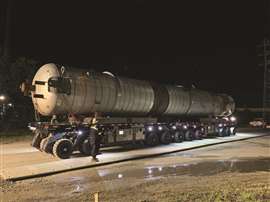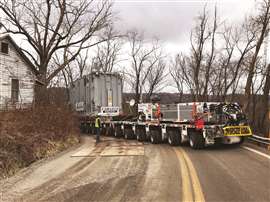What’s going on in the North American SPMT market?
06 February 2024
For many years, self-propelled modular transporters (SPMTs) were considered complicated and expensive. Only the “big guys” in North America had SPMTs in their fleets. But in time, as the usage and versatility of these machines expanded, more companies saw a reason to add them to their fleets.
Over the past decade, SPMT usage has exploded in North America, with new models catering to all sizes of rigging, lifting and transport businesses.
 TII Scheuerle provides a telematics system, Scheuerle Connect, which offers basic remote diagnostic functions as well as intelligent analysis features.
TII Scheuerle provides a telematics system, Scheuerle Connect, which offers basic remote diagnostic functions as well as intelligent analysis features.
“They had always been an important tool in the arsenal of the big companies, but now they are accessible to the smaller companies,” said Hale Trailer’s Matthew Schattgen. “SPMTs are more affordable, easier to service and to use. When you can off-load a huge payload without having to mobilize a 500-ton crawler crane, you can pay for a SPMT with just one project.”
Robust market
TII Scheuerle’s Thomas Ziegler, who oversees North America sales, contends the market for SPMTs is robust and steadily growing.
“With the continent’s diverse industries and the need for efficient, heavy load transportation, SPMTs have found widespread applications,” he said. “The worldwide market for SPMTs is similarly thriving, as industries across the globe recognize the benefits of this transport technology.”
Schattgen, whose company Hale Trailer represents the Cometto line of SPMTs (produced by Faymonville), wholly agreed.
“The SPMT market in the U.S. is quickly growing,” he said. “Many industries that have traditionally utilized SPMTs, like oil and gas and shipbuilding, are busy drawing demand for larger and larger fleets. Meanwhile non-traditional market segments like space, solar and heavy industrial manufacturing are demanding new solutions for their rapidly growing businesses, leading to high demand beyond the typical customers.”
Goldhofer’s Florian Bischofberger said the SPMT market in the United States has seen positive growth in recent years.
“This growth is attributed to several factors, including the increasing demand for high-capacity vehicles with high payload and advanced technology,” he said. “This market trend can also be seen in the global environment, as loads are becoming larger and heavier and demands on transport systems are constantly increasing.”
Industry pioneers
The advent of the SPMT began close to 50 years ago. TII Scheuerle was a pioneer in the market, helping to develop this important rigging and transport system with Mammoet. After several years of research and development, in 1984 TII Scheuerle invented the SPMT as it is known today, according to Ziegler.
“It’s a solution that can be transported quickly, efficiently and easily to any location in the world,” Ziegler said. “The SPMT in container width can be transported on flat rack containers. Our customers can now realize projects in the most remote parts of the world with much lower freight costs. We are proud that even our initially internal name SPMT has over the years become a global synonym for self-propelled heavy-duty vehicles and a technological standard.
 The first space shuttle transporter for NASA was a Cometto SPMT. Under the principles of its parent company Faymonville, Cometto is bringing consistent and reliable SPMTs to the market.
The first space shuttle transporter for NASA was a Cometto SPMT. Under the principles of its parent company Faymonville, Cometto is bringing consistent and reliable SPMTs to the market.
Ziegler estimates that Scheuerle’s presence in North America is significant, and that the company has almost 28,000 axle lines in service. Cometto also has a proud history in the SPMT market in the United States.
“The first space shuttle transporter for NASA was a Cometto, and since then they have engineered a stronger, safer and easier to operate SPMT,” Schattgen said. “Also, manufacturing principles adopted from the parent company Faymonville have brought a more consistent and reliable machine to the market.”
Customer driven
Cometto is a leader in listening to its customers, Schattgen said. He pointed to the Cometto ECO1000 as the tiny workhorse of SPMTs designed to be simple to operate and to quickly integrate multiple units for payloads up to 1,000 metric tons. The Cometto MSPE is the heavy version of SPMT. They are offered in 48 metric tons or 70 metric tons capacity per axle lines and are intended for everyday payloads to beyond 20,000 metric tons.
The Cometto ModulMAX is the lower version of SPMT on smaller more readily available tires. These SPMTs are offered in mechanical or electronic steering and have a capacity of 45 tons per axle line. Schattgen estimates that Cometto has approximately 500 axle lines operating within the United States. The appeal of SPMTs spans a host of industries.
“Manufacturing is one I’d say is the most interesting right now,” said Schattgen. “Many companies are exploring new ways to control product assembly and optimize their offerings. If components that were typically field installed can now be completed at the factory, thanks to larger moving capabilities, the customers will reduce cost and risk with field installation.”
Faymonville’s Cometto subsidiary is constantly working on new products.
“As industry looks for more automation we will bring new technology to move large components without personnel,” Schattgen said. “We have already integrated self-driving applications into transporters and this field will see rapid development for heavy industry worldwide.”
Comprehensive product line
TII Scheuerle offers a comprehensive SPMT product line that includes models such as the SPMT PowerHoss, SPMT K24 and further self-propelled modules like InterCombi SPE.
“The loading capacity depends on the particular version and can accommodate up to a maximum of 60 metric tons per axle line,” said Ziegler. “Additionally, we provide a range of accessories like extending or split systems to enhance the customization of our SPMTs, including performance packages, power packs, lighting systems, winter packages and various coupling options.”
Ziegler said industries such as construction, oil and gas, power generation, aerospace, onshore and offshore wind energy and shipbuilding industries have widely adopted SPMTs for moving, hauling and lifting tasks.
“The adaptability of SPMTs makes them indispensable in situations where precision, safety and flexibility are paramount, leading to their integration into many industrial sectors,” Ziegler said.
For all product lines and associated Power Pack Units (PPUs), Scheuerle now provides a proprietary telematics system, known as Scheuerle Connect.
“This advanced system not only offers basic remote diagnosis functions but goes beyond by providing intelligent analysis features, collectively known as Smart Services,” explained Ziegler. “Scheuerle Connect includes a specialized online portal through which the SPMTs proactively signal service needs before a module experiences downtime.”
 A market leader in modular trailers and hydrostatically powered transporters, Goldhofer is developing cost-effective solutions for transporting heavy loads.
A market leader in modular trailers and hydrostatically powered transporters, Goldhofer is developing cost-effective solutions for transporting heavy loads.
Pursuing new solutions
As one of the market leaders in the field of heavy-duty modular trailers and hydrostatically powered modular transporters, Goldhofer has set itself the goal of developing cost-effective solutions for its customers in the business of transporting heavy loads, according to Bischofberger.
“Goldhofer has been committed for decades to the continuous further development of our internationally acclaimed modular systems, which are deployed for all kinds of transport operations under the most demanding conditions,” he said. “This is only possible in a permanent dialog with our customers, who appreciate this continuity and support us with their practical experience. As a result, we are able to continue to develop the new and economical solutions for the constantly changing transport requirements that our customers have to meet to remain successful.”
Product innovations
Goldhofer offers several SPMT models, including PST/SL-E, PST/ES-E (electrically steered) as well as PST/SL and the ADDRIVE (mechanically steered), and an extensive line of accessories. Bischofberger said Goldhofer SPMTs are utilized in a wide variety of industries.
“Even if SPMTs are used for road transportation, especially for the ‘last mile’, one of the main applications is internal transport in all kinds of industries including shipyards, the wind industry, petrochemicals, oil and gas and the like,” Bischofberger said.
As far as new products, Bischofberger said Goldhofer is continually working on product development. Asked if he can give a hint about new products he said, “You will need to wait for Bauma 2025.”
STAY CONNECTED


Receive the information you need when you need it through our world-leading magazines, newsletters and daily briefings.




